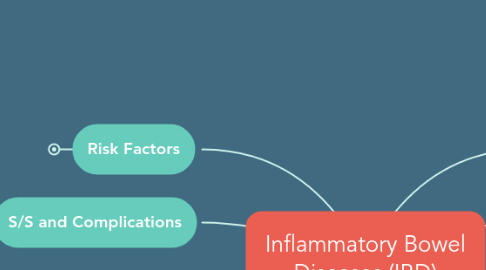
1. Risk Factors
1.1. Family history
1.2. White and Ashkenazi Jewish
2. S/S and Complications
2.1. UC vs CD
2.2. Extraintestinal manifestations
3. Treatment & Nursing Care
3.1. Acute
3.1.1. Bowel rest
3.1.1.1. NPO
3.1.1.1.1. Parental nutrition
3.1.2. IV fluids, electrolytes, minerals
3.1.2.1. Strict I&Os
3.1.2.2. Iron, cobalamin, folate, zinc
3.1.3. Anti-inflammatory
3.1.3.1. Corticosteroids
3.1.3.1.1. Prednisone
3.1.3.1.2. Hydrocortisone
3.1.3.1.3. Methylprednisolone
3.1.3.2. Aminosalicylates
3.1.3.2.1. Mesalamine
3.1.3.2.2. Sulfasalazine
3.1.3.3. Immunosuppressants
3.1.3.3.1. Cyclosporine
3.1.3.3.2. Methotrexate
3.1.3.4. Biologic therapies
3.1.3.4.1. Adalimumab (Humira)
3.1.3.4.2. Infliximab (Remicade)
3.1.3.5. All these medications cause myelosuppression
3.1.4. Antibiotics
3.1.4.1. Fluoroquinolone
3.1.4.2. Metronidazole
3.2. Perineal care
3.2.1. Moisturizing skin barrier
3.2.2. Perineal pain
3.2.2.1. Sitz bath
3.2.2.2. Cool compress
3.2.2.3. Witch hazel
3.3. Surgical Therapy
4. Labs and Diagnostics
4.1. CBC
4.1.1. Low H/H
4.1.2. High WBC
4.1.2.1. Toxic megacolon
4.1.2.2. Perforation
4.2. BMP
4.2.1. Low Na, Cl, K
4.3. Albumin and pre-albumin
4.3.1. Determine the nutritional status
4.4. High ESR and CRP
4.4.1. Inflammation
4.5. Stool culture
4.5.1. R/O GI infection
4.6. Imagings
4.6.1. X-rays
4.6.1.1. Double-contrast barium enema
4.6.2. Abdominal US
4.6.3. CT or MRI
4.7. Colonoscopy
5. Location & Pattern
5.1. Location of UC and CD
5.1.1. UC
5.1.1.1. Begins in rectum
5.1.1.1.1. Continuous
5.1.2. CD
5.1.2.1. Involves all the layers of the GI tract
5.1.2.1.1. Non-continuous patches
5.1.2.1.2. Common in terminal ileum
6. Types
6.1. Ulcerative colitis (UC)
6.2. Crohn's disease (CD)
7. Concepts
7.1. Inflammation
7.1.1. Inflammatory process
7.2. Bleeding
7.2.1. Bloody stools
7.3. Pain
7.3.1. Abdominal cramping
7.4. Nutrition
7.4.1. Malabsorption
7.4.2. Weight loss
7.5. GI Elimination
7.5.1. Diarrhea
7.5.1.1. Fluid and Electrolyte Balance (Risk for)
